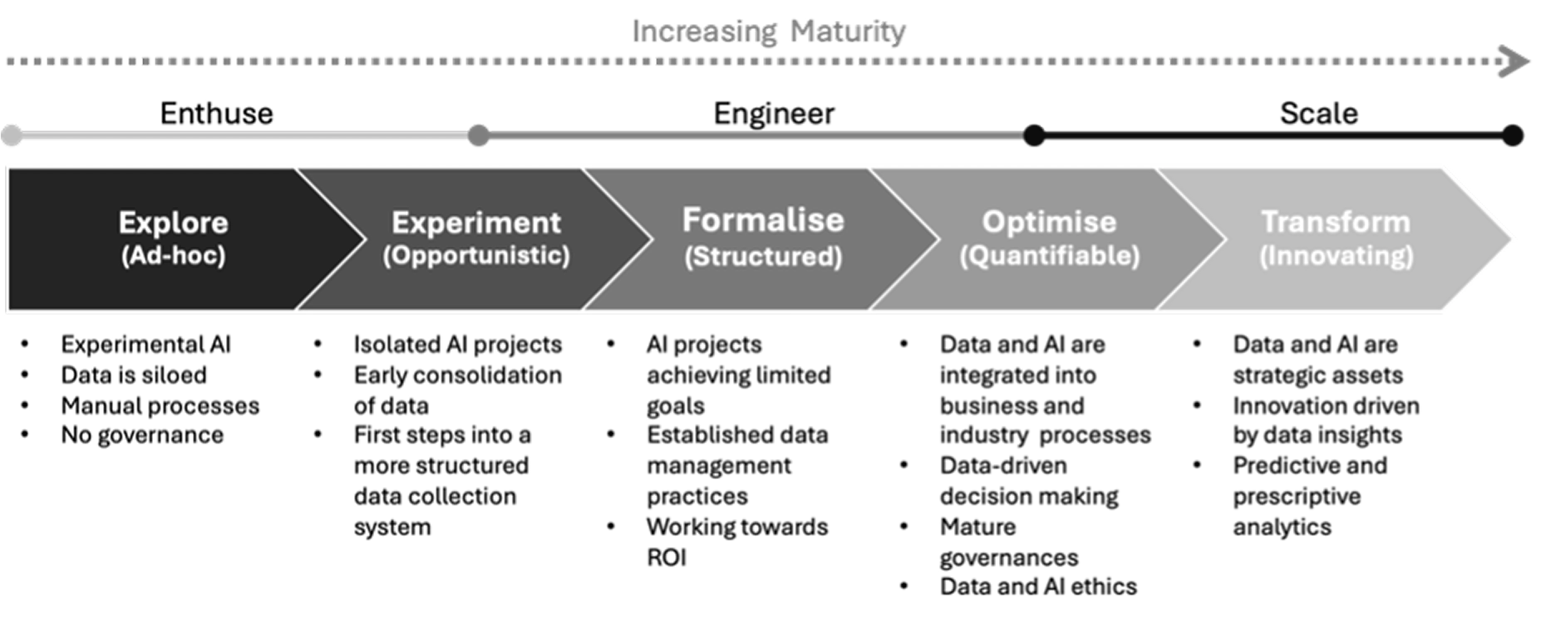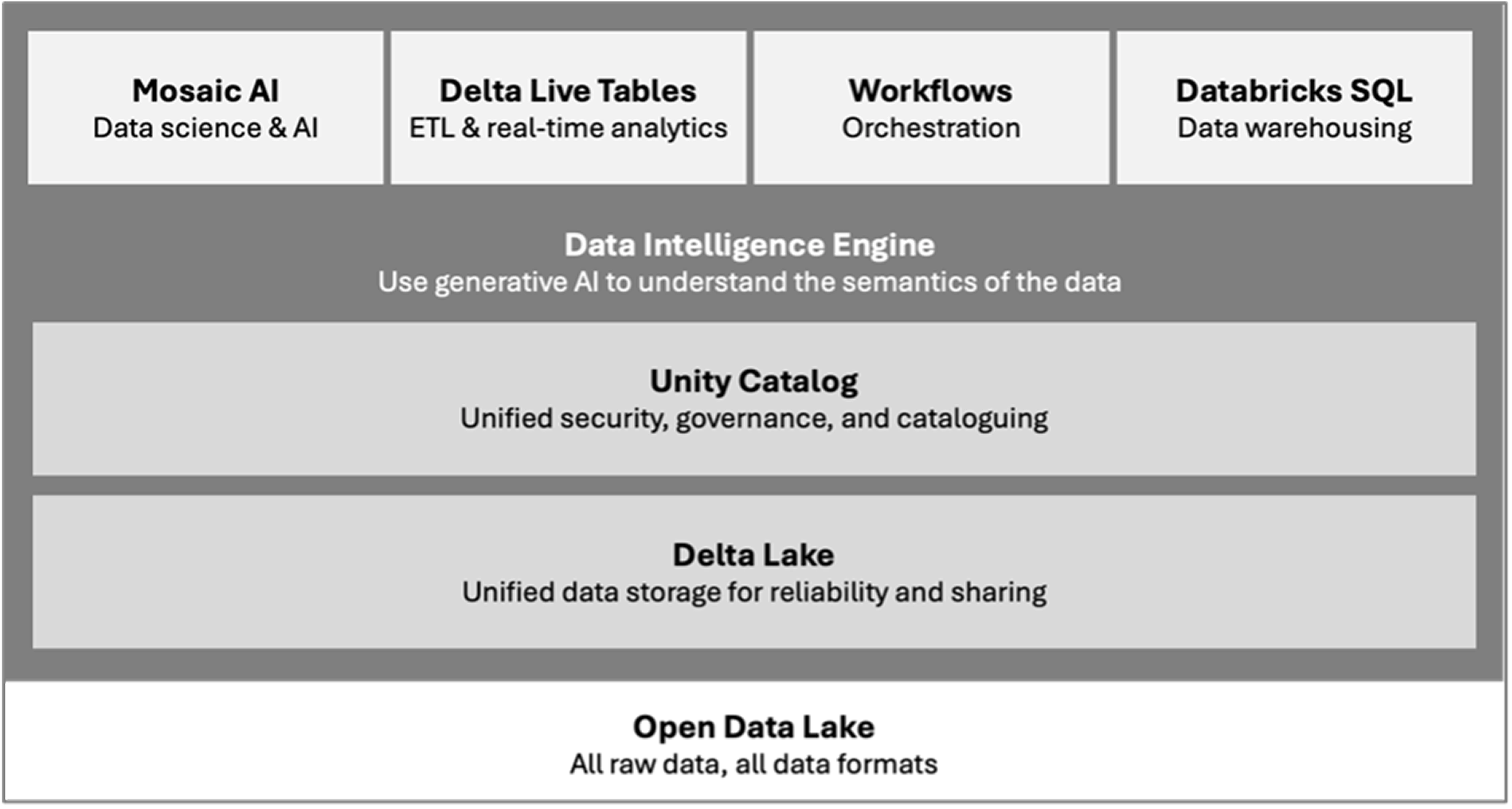Beyond Implementation:
Driving ROI with a Strategic Data and AI Approach on Databricks

Bala Amavasai
CTO for Industry, Celebal Technologies

Frank Tüg
Senior Manager Value Consulting, Databricks
7 min readMay 29, 2025
In this blog post, I am excited to be joined by Frank Tüg, a seasoned Databricks consultant with over 30 years of experience bridging the gap between technology and business value. Like me, Frank doesn’t just advocate for platforms—he champions strategies that turn data into measurable ROI.
Our mantra? “Technology is the enabler, but ROI is the ultimate metric.”
AI Generated TL;DR
Successful Databricks implementation hinges on a well-articulated data and AI strategy, guiding organizations from initial adoption to realising significant ROI. This blog post highlights that many organizations begin with fragmented data and experimental AI projects but need to evolve towards a more mature state, because the future winners in every industry will be the data and AI companies. To illustrate this evolution, the authors present a maturity model, detailing phases from “Explore” (ad hoc) to “Transform” (innovating at scale). This progression involves establishing structured data management, integrating AI into business processes, and leveraging data for predictive and prescriptive analytics. This blog underscores that Databricks’ Data Intelligence Platform facilitates this journey, but strategic planning and execution, and the interface between people, process, and technology, are paramount for maximising its value and achieving data-driven innovation.
Building a Powerful Data and AI Strategy with Databricks
So, your organization has lots of data, and you have rightly adopted Databricks. What’s next?
Simply having data isn’t enough. To truly unlock its potential and gain a competitive edge, organizations need a well-defined Data and AI Strategy that leads to execution. When it comes to implementing that strategy, Databricks offers a unified platform that can be a great enabler. We have to remind ourselves that a data and AI strategy is not a one-and-done checklist. Instead, it is a dynamic roadmap that must adapt as swiftly as the innovations reshaping our digital landscape.
Take the advent of Generative AI (GenAI), for instance. Its explosive rise has not just expanded what is technically achievable; it has fundamentally altered how organizations approach everything from data infrastructure and model training to ethical guardrails and real-world deployment.

Figure 1. Maturity of organizations in adopting data and AI technologies
Adopting Databricks’ Data Intelligence Platform is more than just a technology implementation; it should be a catalyst for evolving your entire data and AI strategy. As illustrated in the maturity model, organizations typically progress from an “Explore” phase, characterized by siloed data and isolated AI projects, towards an “Experiment” phase, where we see early consolidation and structured data collection, enabling AI to achieve more tangible results.
Ultimately, the goal is to reach the “Transform” phase, where data and AI are fully integrated into business processes, driving data-driven decision-making, mature governance, and ultimately positioning data and AI as strategic assets that fuel innovation through advanced analytics. Databricks facilitates this journey by providing the unified foundation necessary to navigate these stages and systematically mature your data and AI capabilities.
This blog article is aimed at industries that are either on the journey or have adopted Databricks and want to evolve their Data and AI Strategy to take full advantage of the platform’s offerings. It will guide you through the essential steps of building a robust Data and AI strategy, highlighting how Databricks can empower each stage of your journey.

Figure 2. The Databricks Data Intelligence Platform
The Seven Pillars of a Successful Data and AI Strategy
Here are the key steps to building your Data and AI strategy:
1. Defining Your North Star and Aligning with Business Goals
- Before diving into technology, the cornerstone of any successful strategy is understanding your business objectives. Ask yourself:
- ✓ What are our key business priorities? (e.g., increasing revenue, improving customer experience, optimizing operations, optimizing the bottom line, launching new products, mitigating operational risks)
- ✓ How can data and AI directly contribute to achieving these goals? Be specific and measurable.
- ✓ What are the critical business questions we need data to answer?
- ✓ What are the desired outcomes and KPIs we want to achieve through data and AI initiatives?
Databricks Advantage:
Databricks’ collaborative platform fosters communication between business stakeholders and technical teams, ensuring alignment from the outset. Its integrated environment allows for seamless translation of business needs into actionable data and AI projects.
2. Assess Your Current Data Landscape: Understanding Your Assets (and Liabilities)
- Next, take a hard look at your existing data ecosystem:
- ✓ What data do we currently collect? Identify all sources, formats, and volumes.
- ✓ Where is our data stored? (e.g., data lakes, data warehouses, time-series databases, operational databases, SaaS applications)
- ✓ What is the quality of our data? Are there issues with accuracy, completeness, consistency, and timeliness?
- ✓ What are our current data management practices? (e.g., governance, security, privacy)
- ✓ What existing tools and technologies do we have for data processing and analysis?
Databricks Advantage:
Databricks excels at connecting to diverse data sources, whether on-premises or in the cloud. Delta Lake provides a reliable and performant data Lakehouse foundation, addressing data quality and governance challenges directly within the platform.
3. Envision Your Future State: Defining Your Data and AI Aspirations
- With a clear understanding of your goals and current state, it’s time to envision the roadmap to get you to your desired future:
- ✓ What data do we need to achieve our objectives? Identify data gaps and potential new sources
- ✓ How should our data be organized and managed for optimal use in AI? Consider a centralized, governed, and accessible data foundation.
- ✓ What AI capabilities do we aspire to build and deploy? (e.g., predictive modelling, natural language processing, computer vision, recommendation systems)
- ✓ What level of data literacy and AI expertise do we need within our organization?
Databricks Advantage:
Databricks’ unified platform supports the entire AI lifecycle, from data engineering and feature engineering to model training, deployment, and monitoring. MLflow integration streamlines the MLOps process, making advanced AI aspirations achievable.
4. Chart Your Course: Defining Key Data and AI Initiatives
Based on your gap analysis, identify specific projects and initiatives that will bridge the gap between your current and desired states. Prioritize these based on:
- ✓ Business Value: Which initiatives will deliver the most significant impact?
- ✓ Feasibility: How complex and resource-intensive are they?
- ✓ Dependencies: Are there any foundational projects that need to be completed first?
Examples of initiatives could include:
- 1. Building a customer 360 view
- 2. Implementing a real-time fraud detection system
- 3. Developing personalized product recommendations
- 4. Automating data ingestion and transformation pipelines
Databricks Advantage:
Databricks’ collaborative environment allows data engineers, data scientists, and business analysts to work together on these initiatives seamlessly, increasing the productivity of the data teams. Its powerful processing capabilities and extensive library support accelerate development and deployment, delivering significant time-to-market improvements.
5. Establishing Data Governance and Architecture
A strong data and AI strategy requires a solid foundation:
- ✓ Data Governance: Define policies, roles, and responsibilities for data ownership, quality, security, and compliance.
- ✓ Data Architecture: Design a scalable and efficient data infrastructure that supports your current and future needs
- ✓ Data Flow: Consider the flow of data, storage solutions, and processing pipelines.
Databricks Advantage:
Databricks’ Data Intelligence Platform enforces data quality and governance directly within the data Lakehouse. Its flexible architecture can integrate with various cloud storage and compute options, allowing you to build a tailored and scalable infrastructure.
6. Empower Your Team: Cultivating Data Literacy and Skills
Your data and AI strategy will only succeed with the right talent and a data-driven culture:
- ✓ Identify the necessary skills: Data engineers, data scientists, ML engineers, data analysts, and business analysts with data acumen.
- ✓ Develop a plan for training and upskilling: Invest in your existing team to enhance their data and AI capabilities.
- ✓ Foster collaboration and knowledge sharing: Break down silos between technical and business teams.
- ✓ Promote data literacy across the organization: Empower everyone to understand and utilize data effectively.
Databricks Advantage:
Databricks provides a unified platform that caters to diverse skill sets, fostering collaboration. Its extensive community support resources and official documentation aid in upskilling and knowledge sharing.
7. Iterate and Evolve: Embracing Continuous Improvement
The data and AI landscape is constantly changing. Your strategy should be a living document that evolves with your business and technological advancements:
- ✓ Establish metrics to track the success of your initiatives.
- ✓ Regularly review and refine your strategy based on learnings and new opportunities.
- ✓ Stay informed about the latest advancements in data and AI technologies.
- ✓ Foster a culture of experimentation and continuous improvement.
Databricks Advantage:
Databricks’ continuous innovation and integration with cutting-edge technologies ensure that you have access to the latest tools and capabilities to adapt and evolve your data and AI strategy.
Conclusion: Building a Data-Driven Future with Databricks and Celebal Technologies
Building a successful Data and AI strategy is a journey that requires careful planning, execution, and continuous adaptation. By focusing on your business goals, understanding your data landscape, and leveraging the power of a unified platform like the Databricks Data Intelligence Platform, you can unlock the true potential of your data and pave the way for innovation and competitive advantage. Embrace the journey, empower your team, and let Databricks be your trusted partner in building a data-driven future.
Celebal Technologies empowers organizations in their data-driven transformation journey, starting with cloud adoption and devising a comprehensive data strategy and solution design. We help organizations adopt the right platform services and derive comprehensive data analytics through quicker modernization at a lower cost. Celebal leverages the capabilities of Databricks to help leading enterprises optimize data processing with a suite of comprehensive AI and analytics solutions.





